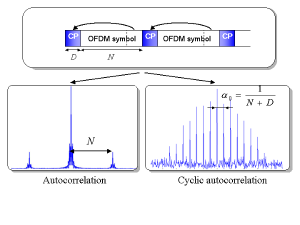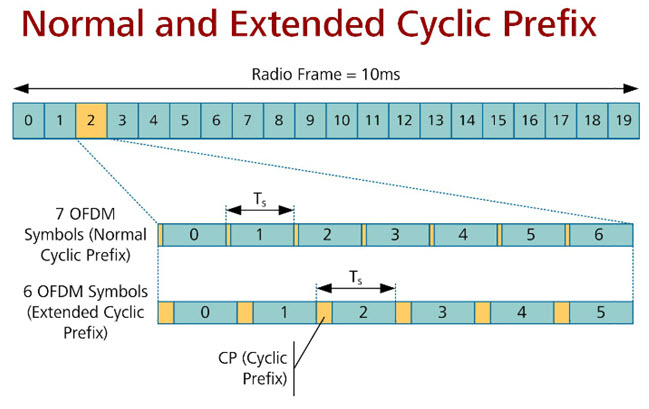OFDM – the digital modulation technique that utilizes multiple subcarriers to transmit data over wireless communication channels, is a marvel of technology. By dividing the frequency band into several narrowband subcarriers, each carrying part of the data stream, it provides high spectral efficiency and robustness against multipath fading. But how does OFDM prevent inter-symbol interference (ISI) caused by this very fading in wireless channels? Enter cyclic prefix (CP), which is added to each OFDM symbol before transmission as a copy of its end portion appended at the beginning creating a guard interval between adjacent symbols. But why is CP necessary? Well, for starters, its length depends on channel delay spread and must be longer than or equal to it; otherwise, ISI could still occur. And yet another perk: the addition of CP converts linear convolution in time domain into circular convolution in frequency domain thus simplifying signal processing and equalization at receiver side while simultaneously improving system performance by mitigating ISI caused by overlapping symbols due to multi-path propagation! So there you have it folks- cyclic prefix plays an irrefutably crucial role in ensuring reliable OFDM symbol transmission over wireless communication channels affected by fading and multipath effects!

Understanding OFDM and its Frequency Division Multiplexing
Contents
- 1 Understanding OFDM and its Frequency Division Multiplexing
- 2 Orthogonal Frequency Division Multiplexing (OFDM) Explained
- 3 Wireless Communication and the Need for Cyclic Prefix
- 4 The Role of Cyclic Prefix in OFDM Symbol Transmission
- 5 Interference and Inter-Symbol Interference (ISI) in OFDM
- 6 Cyclic Prefix and Linear Convolution in Wireless Communication
- 7 Guard Interval and Equalization in OFDM for Multipath Channel Communication.
Behold the enigma that is Orthogonal Frequency Division Multiplexing (OFDM), a technique that defies the norm in wireless communication by transmuting high-speed digital signals into multiple lower-speed sub-signals. These sub-signals, like fireflies dancing to their own tune, are transmitted simultaneously over different frequencies, creating a symphony of efficiency and reduced interference.

But wait, there’s more! The cyclic prefix adds another layer of complexity to OFDM. It takes an OFDM symbol and stretches it out with redundant data at the end. This strange transformation helps prevent inter-symbol interference (ISI) caused by pesky multipath channel effects where symbols overlap.
And if you thought OFDM was done being perplexing, think again! Enter linear convolution – an essential ingredient for successful wireless communication using OFDM. By convolving the input signal with a finite impulse response filter, unwanted frequency components can be removed, giving way to clearer transmission and reception over long distances. Mind-blowing stuff indeed!
Orthogonal Frequency Division Multiplexing (OFDM) Explained
Have you heard of Orthogonal Frequency Division Multiplexing (OFDM)? It’s a digital communication technique that utilizes multiple carriers to transmit data over a frequency band. But here’s the kicker – instead of just sending all the data at once, OFDM divides the available bandwidth into several subcarriers and then modulates each one with a different symbol. This allows for large amounts of data to be transmitted at high speeds, which is pretty impressive.
However, as with any good thing, there are challenges that come along with it. In this case, interference caused by multipath propagation is one major issue when using wireless communication systems employing OFDM. This type of interference leads to inter-symbol interference (ISI), meaning symbols transmitted in adjacent time intervals interfere with each other due to reflections from obstacles or signal diffraction – how perplexing!
To combat this problem, cyclic prefix comes into play. Cyclic prefix involves copying part of the end portion of an OFDM symbol and adding it to its beginning as a guard interval – mind-blowing! The duration of this guard interval must be greater than or equal to the maximum delay spread caused by multipath propagation so linear convolution can be converted into circular convolution in the frequency domain – sounds complex but stay with me.
This conversion simplifies equalization at the receiver end and ultimately enables reliable wireless communication even under challenging conditions such as multipath propagation and interference from other sources without compromising on speed or quality – wowza!
And let’s not forget about Fast Fourier Transform (FFT) algorithm being used for processing signals efficiently in an OFDM system since it quickly converts time-domain samples into discrete-frequency domain representation accurately. All these techniques combined result in top-notch wireless communication capabilities that truly amaze!
Wireless Communication and the Need for Cyclic Prefix
The ubiquity of wireless communication in our daily lives is undeniable and its significance only continues to burgeon. However, navigating the labyrinthine multipath channels inherent in this mode of transmission poses a primary obstacle. The signals transmitted from a transmitter may take multiple paths before arriving at the receiver, causing interference and distortion that can significantly degrade signal quality.
To surmount these formidable challenges, Orthogonal Frequency Division Multiplexing (OFDM) was introduced as a modulation scheme for wireless communication systems. OFDM subdivides the frequency band into numerous subcarriers implementing Fourier transform concepts. Each subcarrier is then modulated separately and simultaneously transmitted to convert data into an OFDM signal.
However, one critical issue with OFDM signals is Inter-Symbol Interference (ISI), which occurs when symbols overlap due to multipath propagation delays. To circumvent this problem, a Cyclic Prefix (CP) concept was introduced in OFDM systems. The CP entails adding some samples from the end of each symbol to its beginning so it becomes longer than x+n-1 samples long; thus linear convolution turns circular convolution resulting in eliminating ISI during transmission.
Equalization techniques are also used along with guard intervals between symbols to compensate for any remaining distortions caused by multipath channels and ensure reliable communication over wireless networks without loss or degradation of data packets even under challenging channel conditions.\n\n
The Role of Cyclic Prefix in OFDM Symbol Transmission
The Orthogonal Frequency Division Multiplexing (OFDM) symbol transmission in wireless communication is a complex process that baffles many. At the core of this technology lies a crucial component known as the cyclic prefix (CP). The CP serves as an enigmatic guard time that enables delay and block copying, allowing for uninterrupted signal transmission.
The significance of this elusive CP cannot be overstated. Without it, different OFDM symbols would overlap and interfere with one another in frequency-selective channels, resulting in inter-symbol interference (ISI). However, adding a copy of the end value of each OFDM symbol at its beginning during transmission using CP merges them into one continuous signal without any interruptions or overlapping between symbols.
This perplexing conversion effectively eliminates intersymbol interference while enhancing system performance remarkably. Additionally, the use of cyclic prefix empowers equalization over signals transmitted via frequency-selective channels by operating on individual subcarriers within each OFDM symbol separately.
To sum up this bursty phenomenon: utilizing cyclic prefix to convert multiple short duration signals into one long continuous signal before transmitting them over a varying delay and attenuation channel allows for improved system performance through reduced ISI and equalization possibilities using an equalizer at the receiver’s end.
Interference and Inter-Symbol Interference (ISI) in OFDM
The perplexing issue of interference and inter-symbol interference (ISI) plagues wireless communication, particularly with the use of multicarrier modulation schemes like OFDM. When symbols overlap at the receiver due to multipath propagation, a distorted signal is received, causing ISI. To counteract this distortion, a guard interval or cyclic prefix must be added to each symbol.
But what exactly is a cyclic prefix? It’s an extension that elongates each symbol by duplicating its end and adding it to the beginning. This creates a safeguard between adjacent symbols and improves estimation while equalizing the received signal at carrier frequencies. The length of this safeguard must account for any delay spread or fading effects in the channel.
OFDM utilizes subcarriers that transmit data over multiple channels simultaneously through FDM combination. However, if significant interference occurs between subcarriers due to ISI or other factors, not only can it affect that specific carrier but also those nearby as well. Therefore, meticulous consideration must go into designing OFDM systems and selecting appropriate parameters for optimal performance.
In conclusion, although OFDM grants efficient use of spectrum resources and improved resistance against fading effects compared to other modulation schemes; additional measures such as cyclic prefixes or guard intervals are necessary for successful transmission without errors caused by unwanted distortions/interferences during the process – bursting forth with clarity amidst confusion!
Cyclic Prefix and Linear Convolution in Wireless Communication
The intricacy of wireless communication is evident in the daunting challenge posed by multipath propagation. This phenomenon occurs when signals ricochet off impediments and arrive at the receiver at varying intervals, causing a delay spread that engenders inter-symbol interference (ISI). The resulting overlapping symbols from distinct transmitted signals can be modeled using linear convolution of a frequency-selective multipath channel.
To counter this dilemma and attain subcarrier orthogonality in OFDM, we must append each symbol with a cyclic prefix that repeats its end at the beginning. The length of this prefix must exceed or equal the maximum delay spread encountered by the signal to preclude ISI caused by reflections arriving after an entire symbol has been dispatched.
Upon receiving such a transmission with a cyclic prefix, we initiate demodulation of each subcarrier through FFT before eliminating any overlapping remnants introduced by ISI using linear convolution of the received signal along with an equalizer filter custom-designed to compensate for frequency-selective channel effects. TCP’s application of these techniques for reliable data transfer over networks affected by packet loss and reordering is worth exploring further.
Guard Interval and Equalization in OFDM for Multipath Channel Communication.
The significance of Guard Interval and Equalization in the realm of OFDM for Multipath Channel Communication cannot be overstated. The former acts as a shield against the interference and inter-symbol interference (ISI) brought about by multipath propagation, with its length being traditionally fixed but now adjustable to optimize system performance.
Equalization is equally important, serving as a means to counteract channel distortion. At its simplest level, equalization algorithms multiply each received symbol by an inverse function of the channel response at that frequency – provided there is little variation across subcarriers or time slots.
But what happens when one confronts severe fading scenarios or channels that shift rapidly? Enter adaptive equalization techniques which leverage feedback from previous symbols to estimate and correct distortions before decoding data bits.
To sum it up, Guard Interval and Equalization are two indispensable factors when it comes to ensuring dependable communication over multipath channels through OFDM modulation schemes. By carving out specific regions for guard intervals whilst simultaneously implementing effective equalization techniques, we can curb the effects of ISI alongside other forms of signal distortion brought on by complex wireless environments such as those found within dense forestry areas or bustling urban locales.


